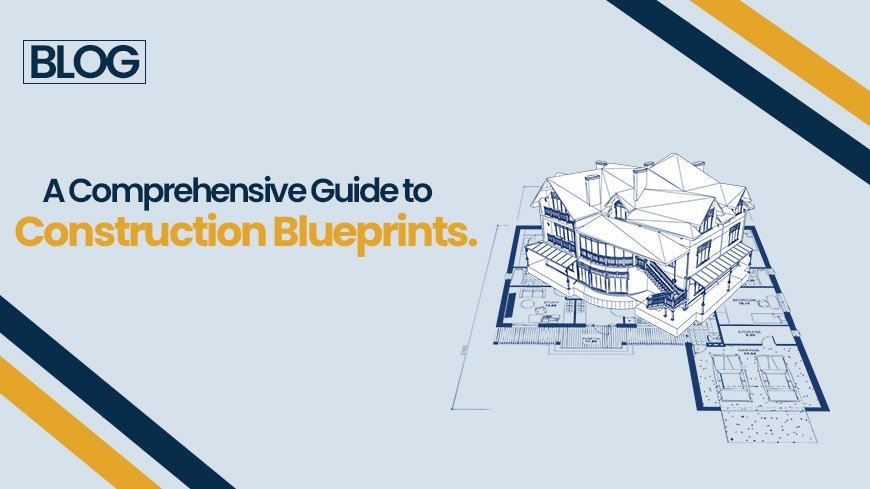- November 30, 2023
- Posted by: Muhammad Shehzad
- Category: Blogs

The construction blueprints are designed for constructing large projects and are sometimes quite complex forming the foundation of every construction project. Blueprints are not just ink on paper, but they are solely for turning an idea into reality in the world of construction. Digital blueprints and BIM are some of the innovations that are revolutionizing the construction sector, improving accuracy and efficiency.
‘The blueprint’ is what lies behind every towering skyscraper, every cozy home, and every functional bridge. These unpretentious sheets of paper are not just documents. They are the forgotten architects who design every building project. To learn more, go through the blog up until the last part since we have discussed each detail.
Blueprints act as a lifeline of the entire construction process and provide the most elaborate and detailed sketch of the design and the construction structure of a project. The intricacy of symbols and carefully drawn lines in blueprints hide the secrets of converting abstract ideas into reality.
What Is The Importance Of Blueprints In Construction?
Blueprints are at the heart of any construction effort. These drawings align all engineers, architects, contractors, laborers, homeowners, and officials from concerned development authorities. They contain all the technical and physical specifications of the project in one single place. As a result, contractors can know how much time they will require as well as the cost incurred on the project.
In addition, the building authorities only issue building permits after the evaluation of these blueprints. These construction drawings must be in complete compliance with local building codes if you are to start constructing your house.
They also act as an effective source for alteration, maintenance, and future remodeling.
Read: How Can Different Types Of Clay Be Used In Construction?
What is Included in Blueprints?
Blueprints are complete guides to contractors, builders, and tradespeople so that the project is done as the architect or engineer intended. These are a type of construction document that gives complete information on how the building is to be erected and designed.
Blueprints typically include the following components:
- Specifications
- Schedules and Lists
- Structural Drawings
- Legend and Symbols
- Mechanical Drawings
- Notes and Annotations
- Architectural Drawings
Blueprints: the Necessity of Construction
Construction blueprints are like detailed maps for building projects. Simply put, construction blueprints are akin to a recipe for the building. They make everybody aware of what is expected, avoid errors, and deliver a product that is in conformity with the plan. It is about making construction projects successful and safe.
They are crucial due to fulfilling various important roles:
Clear Visuals:
Blueprints are very clear pictures of how a construction project will look once it is complete. This makes it clear to everyone involved.
Detailed Plans:
These details include measurements, materials, and ways the things fit together. These details make sure that the project is built correctly.
Accuracy:
Blueprints keep things precise. They are precise, guaranteeing that the project conforms to the design and safety rules.
Communication:
Blueprints are a common language among architects, builders, engineers, and even clients. They support everyone to discuss the project.
Planning:
They are used before the construction starts to plan things. They help in identifying the necessities, the order of things, and the way to solve problems.
Following Rules:
Many laws and regulations mandate the creation of blueprints to ensure the structure adheres to safety measures. Your project may given a green light based on an accurate blueprint.
Fewer Mistakes:
This makes errors, and change less likely with detailed blueprints. This ensures that the project is on schedule and within the budget.
Record Keeping:
Blueprints are like historical documents of construction. They could be useful for work and future inspections.
Teamwork:
The blueprints also assist other experts such as architects, engineers, and builders cooperating well to complete their work. It eases the construction process.
Quality Control:
They are used to ascertain that a work has met all quality standards.
Views in Construction Blueprints
A “view” in construction blueprints means a graphical representation of a particular aspect, including dimensions, of the building, but from a certain perspective. Certain aspects of the construction project cannot done without views. These views help the pros to create an appropriate design model and its implementation.
View Types In Construction Blueprints
The way to read structural drawings begins with understanding the various viewpoints taken by architects and engineers when preparing drawings.
Construction drawings employ three distinct view types:
Plan View: This is a horizontal cross-section of the building and it looks from the bird’s eye view. There is a separate plan view drawing for every floor in the building.
Elevation View: This vertical plane drawing shows the appearance of the structure from the front, back, right, or left side. This will involve internal and external elevation view drawings.
Cross-Section View: The construction plan is also along a vertical plane but slices through the structure to show what lies within. The cross-section view shows the placement of wall studs, insulation material sheathing, and so on.
Also Read: Why Should You Choose A Perfect Real Estate And Construction Company?
How to Read Construction Blueprints?
Understanding construction blueprints involves following a logical sequence. Each blueprint has clear symbols and organized drawing pages.
Begin with the title block, the blueprint’s initial sheet with crucial details:
- Scale
- Design date
- Project name
- Sheet count
- Architect’s contact
- Construction company name
- Relevant government approval info
Conclusion
Construction blueprints form the backbone of large-scale projects, translating concepts into reality. Innovations like digital blueprints and BIM are reshaping the construction field, enhancing accuracy and efficiency. They’re essential guides aligning everyone involved and serving as a detailed roadmap for construction, encompassing specifications, schedules, drawings, and essential communication tools. Blueprints offer clear visuals, detailed plans, and a common language for all stakeholders, ensuring accuracy, compliance, and successful project completion.
